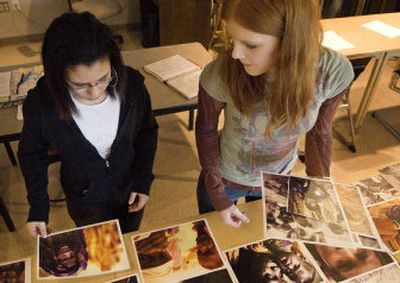Students embrace stark reality: High school campaign to focus on genocide

When University High School students return from their holiday break in early January, they’ll be greeted with some disturbing images. A 15- by 6-foot photo collage, dripping with blood-red colored paint, will hang in the school’s entryway. The banner depicts the terror of genocide and illustrates the suffering, pain and death of a group of people being systematically destroyed.
Students in Vicky Jensen’s advanced drawing class on Monday sifted through piles of photos from the most horrific genocides of the 20th century … the Holocaust, Armenia, Bosnia, Cambodia and Rwanda. These photos will be included in the murals to teach students and staff about genocide.
“This is very empowering for an artist,” said Jensen. “It’s connecting them with life and helping them to realize what a powerful communication tool we have here.”
The U-Hi students are launching a campaign to raise money for the victims of the genocide now taking place in the Darfur region of Sudan.
Social studies teacher Paul Schneider got the idea after noticing three U-Hi students wearing T-shirts that read “Stop genocide in the Sudan.”
“Students are one of the best positive forces of change,” said Schneider. “We work with amazing kids every day. I thought, why don’t we make it a school project?”
Schneider ran the idea by some of the school’s seniors and juniors, who quickly got on board. They invited any interested students to a meeting, and 70 showed up.
“We’ll call a prom meeting, which is important, and we’ll get the senior class officers and maybe a couple of other people, so I really wasn’t expecting much,” said Kathryn Clark, senior class vice president. “To get that many people was amazing. Our school is very passionate about this.”
A flier on a classroom door in the social studies wing of the school reads, “If the pictures of thousands of human bodies being gnawed on by dogs do not wake us from our apathy I don’t know what will.”
“We need to be shocked. I wrote a story for our school newspaper about Darfur, and I couldn’t believe how many people didn’t know what genocide was,” said Clark. “It’s incredible. It’s such a huge problem in our world and something we need to learn about.”
The student-led campaign is divided into three parts. The first part, beginning in January, is about education. Through murals, banners, fliers and video productions, students will learn about genocide.
Phase two is “a call to action.” At the Martin Luther King Jr. assembly planned for Jan. 12, students will use music, multimedia presentations and speakers to illustrate the atrocities of genocide, expanding King’s message of human rights to a broader social conscience.
At the end of the presentation, students and staff will be asked to purchase $5 T-shirts with proceeds going to aid the people of Darfur. The goal is to raise $10,000.
“It’s do-able. We have the will. We have the means and the support of our students and the community. Ten thousand dollars is the floor – there’s no ceiling,” said Schneider.
The last phase, planned for sometime in late February, is the “day of conscience,” when all the students and staff will wear their T-shirts to school and a check will be presented to Project Care, an organization directly involved in providing humanitarian aid to the Sudanese people.